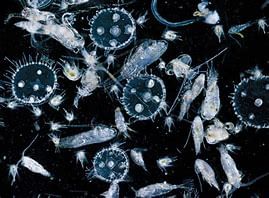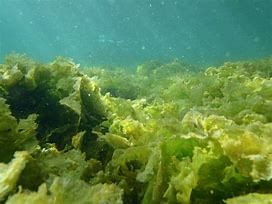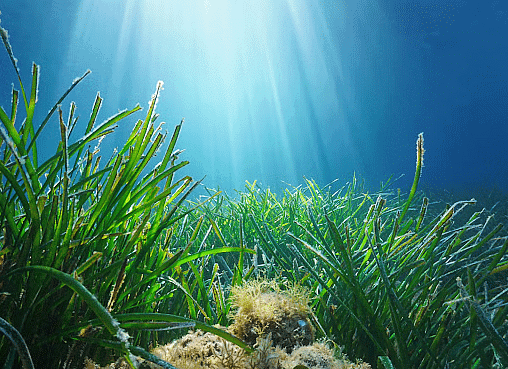Shankar IAS Summary: Marine Organisms | Famous Books for UPSC Exam (Summary & Tests) PDF Download
| Table of contents |

|
| Plankton |

|
| Phytoplankton |

|
| Zooplankton |

|
| Sea Grass |

|
| Seaweeds |

|
Plankton

Definition:
- Plankton encompasses organisms that float on the surface of rivers, lakes, and oceans.
- Two main categories:
- Phytoplankton: Microscopic plants like algae.
- Zooplankton: Small animals such as crustaceans and protozoans.
- Present in all aquatic ecosystems except fast-flowing waters.
Distribution and Movement:
- Plankton's movement is primarily governed by aquatic currents.
- Limited locomotory abilities influence their dispersal.
Characteristics and Significance:
- Growth Rate and Productivity: Particularly high in tropical waters and mangrove ecosystems.
- Species Diversity: Varied plankton species contribute to ecosystem richness.
- Serve as foundational components of aquatic food webs.
- Includes both microscopic plants like algae (phytoplankton) and animals like crustaceans and protozoans (zooplankton) found in all aquatic ecosystems, except certain swift moving waters.
- The major inorganic nutrients required by phytoplankton for growth and reproduction are nitrogen and phosphorus. Marine phytoplankton are not uniformly distributed throughout the oceans of the world.
- The highest concentrations are found at high latitudes, with the exception of bliwelling areas on the continental shelves, While the tropics and subtropics. Phytoplanktons are the foundation of the aquatic food web, the primary producers
- Phytoplankton are responsible for most of the transfer of carbon dioxide from the atmosphere to the ocean. Carbon dioxide is consumed during photosynthesis, and the carbon is incorporated in the - phytoplankton, just as carbon is stored in the wood and leaves of a tree.
Phytoplankton

Definition and Characteristics:
- Phytoplankton: Microscopic plant organisms inhabiting both saltwater and freshwater environments.
- Comprise bacteria, protists, and single-celled plants like cyanobacteria, diatoms, dinoflagellates, green algae, and coccolithophores.
- Essential for oxygen production, generating more oxygen than all land plants combined.
- Possess chlorophyll for photosynthesis, utilizing sunlight to produce chemical energy and oxygen while consuming carbon dioxide.
- Found in illuminated regions of all oceans, including polar areas.
- Total biomass surpasses that of all land plants, serving as primary producers in aquatic ecosystems.
Factors Affecting Phytoplankton:
- Light: Limited to upper ocean layers with sufficient light for photosynthesis; photosynthetic rate varies with light intensity.
- Nutrients: Primary nutrients for growth and reproduction are nitrogen and phosphorus; diatoms and silicoflagellates also require silicate.
- Temperature: Influences growth rates; extremes can limit productivity.
- Salinity: Primary in marine environments; affects phytoplankton distribution and species composition.
- Grazing by Zooplankton: Zooplankton grazing rates impact phytoplankton abundance and size distribution.
- Distribution: Phytoplankton distribution not uniform globally; influenced by temperature, nutrient availability, light exposure, and salinity.
- Productivity: Limited by factors such as sunlight availability and nutrient supply, particularly in nutrient-poor regions like open ocean gyres.
Importance of Phytoplankton
Foundation of the Aquatic Food Web:
- Phytoplankton serve as the primary producers in aquatic ecosystems, forming the base of the food chain.
- They are consumed by microscopic animals, small fish, invertebrates, and larger predators, sustaining the entire aquatic food web.
Role in the Carbon Cycle and Climate Change:
- Carbon Sequestration: Phytoplankton are crucial for the transfer of carbon dioxide from the atmosphere to the ocean through photosynthesis.
- During photosynthesis, carbon dioxide is absorbed, and carbon is incorporated into phytoplankton biomass.
- Similar to how carbon is stored in trees, carbon is stored in phytoplankton.
- Climate Regulation: Phytoplankton play a significant role in regulating global climate by influencing atmospheric carbon dioxide concentrations.
- Worldwide, phytoplankton contribute to the biological carbon pump, transferring approximately 10 gigatons of carbon from the atmosphere to the deep ocean annually.
- Even small changes in phytoplankton growth rates can impact atmospheric carbon dioxide concentrations, potentially leading to feedback effects on global temperatures.
Ecological and Environmental Impact:
- Phytoplankton abundance and activity impact marine ecosystems' health and productivity.
- Changes in phytoplankton populations can affect nutrient cycling, oxygen levels, and biodiversity in aquatic environments.
- Monitoring phytoplankton dynamics is essential for understanding and managing marine ecosystems and addressing climate change implications.
Zooplankton
Definition and Characteristics:
- Zooplankton refers to the diverse group of microscopic animals that drift in aquatic environments.
- They play integral roles within aquatic ecosystems, contributing to nutrient cycling, food webs, and ecosystem dynamics.
Indicator of Ecosystem Health:
- Zooplankton communities serve as indicators of ecosystem health and productivity.
- Assessment of zooplankton diversity, abundance, and species composition helps evaluate ecosystem quality and health.
- Used for assessing the productivity of ecosystems concerning fisheries, fertility, and overall health status.
Variety of Species:
- Zooplankton encompass various species, including tiny flagellates and larger organisms such as giant jellyfish (>50 cm).
- Diversity within zooplankton communities reflects the overall health and productivity of aquatic ecosystems.
Sea Grass
Sea grasses are marine flowering plants (angiosperms) with a grass-like appearance, producing flowers, strap-like or oval leaves, and a root system.
- They thrive in shallow coastal waters with sandy or muddy bottoms, requiring relatively calm areas.
- Unique as the only group of higher plants adapted to life in saltwater.
- Major sea grass meadows in India are found along the south-east coast of Tamil Nadu and in the lagoons of a few Lakshadweep Islands, with some grass beds around Andaman and Nicobar islands.
- The abundant growth of seagrasses in Tamil Nadu and Lakshadweep is attributed to high salinity, water clarity, and sandy substrate.

Functions of Sea Grass
- Sea grass beds physically help:
- Reduce wave and current energy.
- Filter suspended sediments from the water.
- Stabilize bottom sediments to control erosion.
- Provide habitat for marine invertebrates and fishes.
- Enhance fish and migratory bird populations in lagoon areas by offering food and shelter.
- Act as nutrient sinks on reef flats and near estuaries, buffering or filtering nutrient and chemical inputs to the marine environment.
Do you know?
The five species of turtles nesting on the Indian coast are Leatherback sea turtle, Green turtle, Olive Ridley, Hawksbill, and Loggerhead turtle.
- IUCN prioritizes the conservation of sea grass.
- Out of 58 world species, fourteen seagrass species are recorded from the Indian coast.
- Commonly distributed from inter-tidal to sub-tidal regions down to 8m depth.
- Dugong, a mammal dependent on sea grass for food, is on the verge of extinction.
Threats to Sea Grass Beds
- Environmental Threats
Eutrophication, siltation, and coastal engineering harm seagrass beds. Eutrophication leads to algal blooms, siltation reduces sunlight penetration, and coastal constructions disrupt natural habitats.
Human-Induced Pressure
Trawling and overexploitation for commerce directly threaten seagrass beds. Trawling damages habitats, while overexploitation depletes seagrass-dependent species, jeopardizing the health and sustainability of these ecosystems.
Management
- Major seagrass beds should be mapped, and areas identified for preservation.
- Dredging should be carried out away from grass beds to prevent siltation and turbidity, which can harm the beds.
Seaweeds
Seaweeds, macroscopic algae known as thalloid plants, lack true tissues like roots, stems, and leaves.
- Larger, visible marine plants, seaweeds, are attached to rocks, corals, and other submerged surfaces in intertidal and shallow subtidal zones of the sea.
- They thrive in shallow coastal waters wherever sizable substrata is available.
- Seaweeds are broadly classified into different classes based on the color of their pigmentation: blue-green, green, brown, and red.

Functions of Seaweeds
- Food for marine organisms.
- Habitat for fish breeding grounds.
- Source of sediment.
Uses of Seaweeds
- Important as food for humans, feed for animals, and fertilizer for plants.
- Used as a drug for goiter treatment, intestinal and stomach disorders.
- Commercially valuable products like agar-agar, alginates, and iodine are extracted from seaweeds.
- Biodegradation of seaweeds can produce economically important gases like methane.
- Some seaweed extracts exhibit antibacterial activity.
- Used as potential indicators of pollution in coastal ecosystems, particularly heavy metal pollution, due to their ability to bind and accumulate metals strongly.
Harmful Effects of Seaweeds
- Rotting seaweed is a potent source of hydrogen sulfide, a highly toxic gas, implicated in some incidents of apparent hydrogen-sulfide poisoning, causing vomiting and diarrhea.
Threats to Seaweeds
- Environmental Threats
Eutrophication, siltation, and coastal engineering harm seagrass beds. Eutrophication leads to algal blooms, siltation reduces sunlight penetration, and coastal constructions disrupt natural habitats.
Human-Induced Pressure
Trawling and overexploitation for commerce directly threaten seaweeds . Trawling damages habitats, while overexploitation depletes seagrass-dependent species, jeopardizing the health and sustainability of these ecosystems.
|
744 videos|1444 docs|633 tests
|
FAQs on Shankar IAS Summary: Marine Organisms - Famous Books for UPSC Exam (Summary & Tests)
| 1. What are some examples of marine organisms mentioned in the article? |  |
| 2. What is the difference between phytoplankton and zooplankton? |  |
| 3. How do sea grass and seaweeds contribute to marine ecosystems? |  |
| 4. Why are plankton considered important in marine ecosystems? |  |
| 5. How do marine organisms like plankton help in regulating the Earth's climate? |  |
















